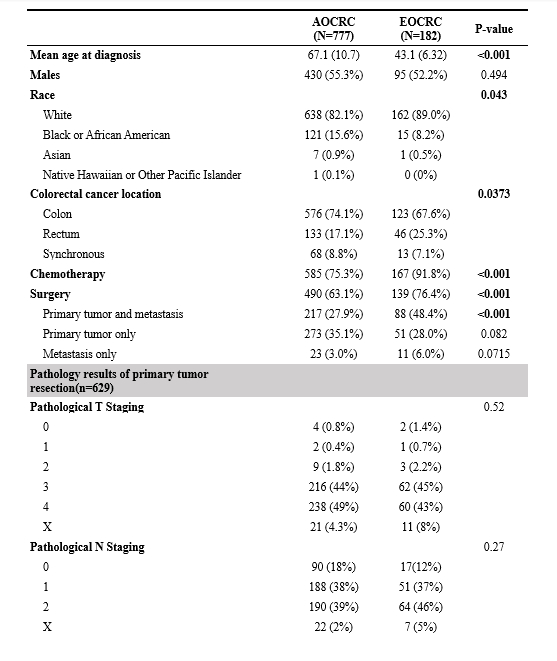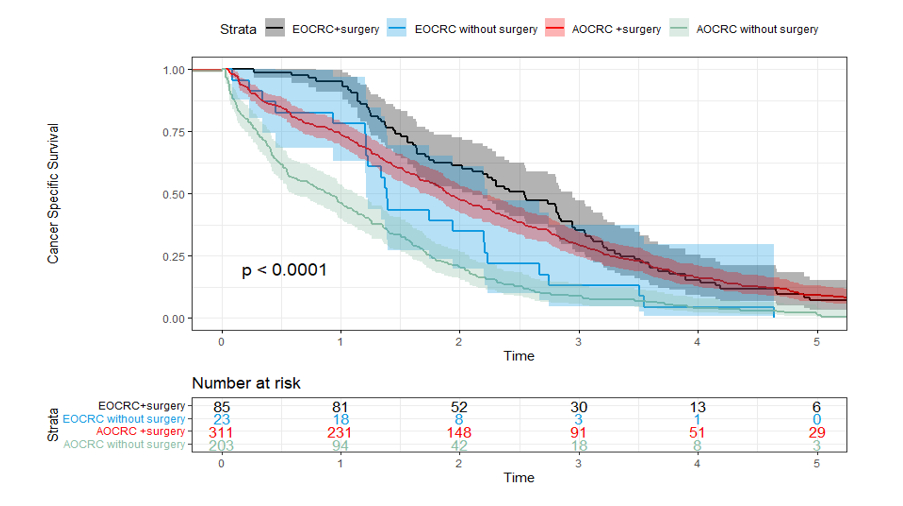Back to 2024 Abstracts
TREATMENT OF STAGE IV EARLY-ONSET COLORECTAL CANCER: A COMPARATIVE ANALYSIS
Faris S. Almadi
*, Jacob G. Mansell, Mikhael Belkovsky, Imran Khan, Emre Gorgun, Joshua Sommovilla, Michael Valente, David Liska
Colorectal Surgery, Cleveland Clinic, Cleveland, OH
Introduction: The incidence of early-onset colorectal cancer (EOCRC), defined as a colorectal cancer diagnosis before the age of 50, is rising globally at an alarming rate for unknown reasons. EOCRC patients are more likely to present with advanced or metastatic disease. While younger patients are often able to tolerate more aggressive treatment regimens, including chemotherapy and surgery, it is controversial if such treatment strategies result in improved oncologic outcomes. We hypothesized that among patients with stage 4 disease, EOCRC patients when compared to average-onset colorectal cancer (AOCRC) patients were more likely to receive chemotherapy and surgery and had better cancer-specific and overall survival.
Methods: We retrospectively reviewed all patients above the age of 18 years old who were diagnosed with stage IV colorectal adenocarcinoma and seen at our institution between 2010-2020. Patients with a hereditary CRC syndrome or diagnosed with inflammatory bowel disease were excluded. Patients aged 18-49 were categorized as EOCRC, while patients 50 or older were categorized as AOCRC. Data was abstracted from our institutional cancer registry and supplemented by an electronic medical record review. Survival analysis was performed with Kaplan-Meier Curves and Cox regression in “R� version 4.3.1.
Results: In total, 959 patients were included; 777 AOCRC and 182 EOCRC patients. The mean age at diagnosis in the AOCRC group was 67.1 years and 43.1 years in the EOCRC group. Rectal cancer was more frequent in EOCRC (25.3% vs. 17.1%; p=0.037). Patients with EOCRC had a higher likelihood of receiving chemotherapy (91.8% vs. 75.3%; p < 0.001) and surgery (76.4% vs. 63.1%; p < 0.001). EOCRC was associated with better OS (p < 0.001), and CSS (p < 0.016). No difference in survival was observed when comparing AOCRC and EOCRC who did not undergo surgery (HR=0.84, CI 0.56-1.25, p=0.4). However, when comparing AOCRC to EOCRC patients treated with surgery, the younger patients had longer survival (HR=0.76, CI 0.61-0.94, p=0.01). (Figure 1)
Conclusions: Stage IV EOCRC patients treated at a tertiary referral center are more likely to be treated with chemotherapy and surgery than older patients and have better overall and cancer-specific survival. The best outcomes were found in EOCRC patients selected for surgical treatment. Further study is required to determine the optimal selection criteria for surgery in metastatic EOCRC.


Back to 2024 Abstracts

